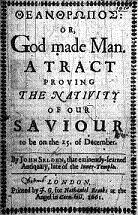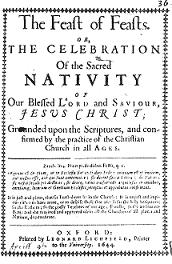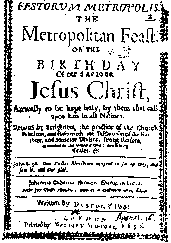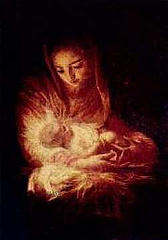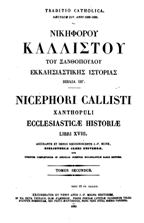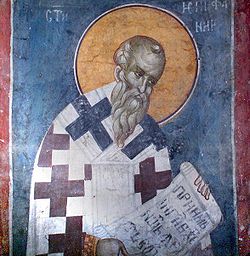The Text Tradition of Hippolytus’
“Commentary on Daniel”
A.D. 170-240
[Editor’s Note: Hippolytus’ commentary on Daniel 4:23 is one of
the earliest testimonies to the traditional date of Christ’s
A question has reached me about the Commentary on Daniel of Hippolytus, especially with regard to the passage n 4.23.3:
“For the first advent of our Lord in the flesh, when he was born
in Bethlehem, eight days before the kalends of January [December
25th], the 4th day of the week [Wednesday], while Augustus was
in his forty-second year, [2 or 3BC] but from Adam five thousand
and five hundred years. He suffered in the thirty third
year, 8 days before the kalends of April [March 25th], the Day
of Preparation, the fifteenth year of Tiberius Caesar [29 or 30
AD], while Rufus and Roubellion and Gaius Caesar, for the 4th
time, and Gaius Cestius Saturninus were Consuls.” (tr. Tom
Schmidt).
Ἡ
γὰρ
πρώτη παρουσία τοῦ
κυρίου
ἡμῶν
ἡ
ἔνσαρκος,
ἐν
ᾗ
γεγέννηται
ἐν
Βηθλεέμ,
ἐγένετο
πρὸ
ὀκτὼ
καλανδῶν
ἰανουαρίων,
ἡμέρᾳ
τετράδι, βασιλεύοντος Αὐγούστου
τεσσαρακοστὸν
καὶ
δεύτερον
ἔτος,
ἀπὸ
δὲ
Ἀδὰμ
πεντακισχιλιοστῷ
καὶ
πεντακοσιοστῷ
ἔτει
ἔπαθεν
δὲ
τριακοστῷ
τρίτῳ
ἔτει
πρὸ
ὀκτὼ
καλανδῶν
ἀπριλίων,
ἡμέρᾳ
παρασκευῇ,
ὀκτωκαιδεκάτῳ
ἔτει
Τιβερίου Καίσαρος,
ὑπατεύοντος
ούφου καὶ
Ῥουβελλίωνος.
But what is the textual basis for this? It doesn’t appear
in the Ante-Nicene Fathers version of the text.
A look at the Sources Chretiennes (14; p. 64) edition
tells me that the Greek text of the work is entirely recovered
from quotations in catenas. In a catena, each quotation
appears underneath the relevant biblical verse, and is labelled
with the name of the author from whom it has been taken.
So the sequence is fairly clear, even if all you have is
extracts, provided that the original author wrote his commentary
in the same sequence as the biblical text.
The process of recovering the commentary began with one of the
great 17th century editors, B. Corderius, who printed the first
fragment of the text in his Expositio patrum graecorum in
psalmos, vol. 3,
The remains seem to be divided into four books. The last
addition to the stock was in 1911, when Dioboutonis printed new
fragments from a 10th century manuscript from the monastery of
Meteores. The end result is a text which contains few
obvious lacunas. However there must still be material
which is lost, especially in book 1.
The text cannot be said to be in good condition. The
manuscripts in which the material is preserved are often in a
poor state, or illegible. The most recent edition, that of
Bonwetsch in the Griechische Christlicher Schriftsteller
1 in 1897 (online, thankfully) often indicates words added by
conjecture or asterisks where there are gaps impossible to fill.
But one compensation is that an Old Slavonic translation exists
of the entire work as it once existed in Greek. This tells
us, of course, that the Greek text must still have existed in
the 10th century when these translations were made. Four
manuscripts of this translation exist, none complete, but which
fortunately have their omissions in different places. This
means that we can read the whole work pretty much as it came
from the hand of the author. The most ancient manuscript
is 12-13th century. Fortunately Bonwetsch translated the
Old Slavonic into German, and the translation was used by the SC
editor to help with the Greek.
Our passage is extant in Greek, and appears on pp.306-7 of the
SC edition. But the SC editor queries whether part of the
text –”Gaius Caesar, for the 4th time, and Gaius Cestius
Saturninus” — was interpolated by a later writer.
The apparatus of Bonwetsch (p.242; p.295 of the PDF) tells us
that this passage was quoted by the Syriac writer George,
Bishop of the Arab tribes. The apparatus also refers to George
Syncellus, and Cyril of Scythopolis as using bits of it.
The text is given in mss. ABP and S; A= Athos, Vatopedi 260 /
Paris suppl. gr. 682 (10-11th century); B=Chalcis 11 (15-16th
c.); P=Paris gr. 159 p.469f.; S=the old Slavonic.
So… the text is reasonably well established, and reasonably
reliable. The Greek for our passage seems sound, with only
a couple of bits in brackets. We have a good early witness
for the text, and also a translation in a 7th century Syriac
writer and a 10th century translation.
______________________________
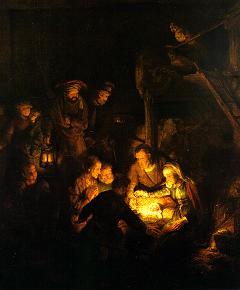
Adoration of the Shepherds
All rights reserved.
 John Seleden’s
John Seleden’s